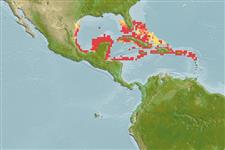Teleostei (teleosts) >
Gobiiformes (Gobies) >
Gobiidae (Gobies) > Gobiinae
Etymology: Elacatinus: Greek, elakatines = fusiform fishes preserved in salt (Ref. 45335).
More on author: Jordan.
Environment: milieu / climate zone / depth range / distribution range
Ecology
Marine; reef-associated; depth range 1 - 45 m (Ref. 9710), usually 1 - 40 m (Ref. 27115). Subtropical; 21°C - 28°C (Ref. 27115); 28°N - 16°N, 98°W - 61°W
Western Central Atlantic: southern Florida to Texas (USA) southward to Belize.
Size / Weight / Age
Maturity: Lm ? range ? - ? cm
Max length : 5.0 cm TL male/unsexed; (Ref. 7251)
Inhabits coral heads. Removes ectoparasites on skin and fins, in the mouth and in the gill chambers of greater fish like groupers and others (Ref. 92840). Monogamous (Ref. 52884). Minimum depth reported from Ref. 27115. Has been reared in captivity (Ref. 35420).
Life cycle and mating behavior
Maturity | Reproduction | Spawning | Eggs | Fecundity | Larvae
Monogamous mating is observed as both obigate and social (Ref. 52884).
Robins, C.R. and G.C. Ray, 1986. A field guide to Atlantic coast fishes of North America. Houghton Mifflin Company, Boston, U.S.A. 354 p. (Ref. 7251)
IUCN Red List Status (Ref. 130435)
Threat to humans
Harmless
Human uses
Aquarium: commercial
More information
ReferencesAquacultureAquaculture profileStrainsGeneticsElectrophoresesHeritabilityDiseasesProcessingNutrientsMass conversion
Tools
Special reports
Download XML
Internet sources
Estimates based on models
Preferred temperature (Ref.
123201): 24.5 - 28, mean 26.7 °C (based on 184 cells).
Phylogenetic diversity index (Ref.
82804): PD
50 = 0.5000 [Uniqueness, from 0.5 = low to 2.0 = high].
Bayesian length-weight: a=0.00794 (0.00436 - 0.01448), b=3.11 (2.95 - 3.27), in cm total length, based on LWR estimates for this species & (Sub)family-body (Ref.
93245).
Trophic level (Ref.
69278): 3.5 ±0.37 se; based on food items.
Resilience (Ref.
120179): High, minimum population doubling time less than 15 months (Preliminary K or Fecundity.).
Fishing Vulnerability (Ref.
59153): Low vulnerability (10 of 100).
Nutrients (Ref.
124155): Calcium = 126 [51, 330] mg/100g; Iron = 1.12 [0.49, 2.30] mg/100g; Protein = 19.1 [17.1, 20.9] %; Omega3 = 0.269 [0.107, 0.594] g/100g; Selenium = 12.4 [4.5, 29.9] μg/100g; VitaminA = 83.9 [20.0, 337.2] μg/100g; Zinc = 1.71 [0.98, 2.85] mg/100g (wet weight);
